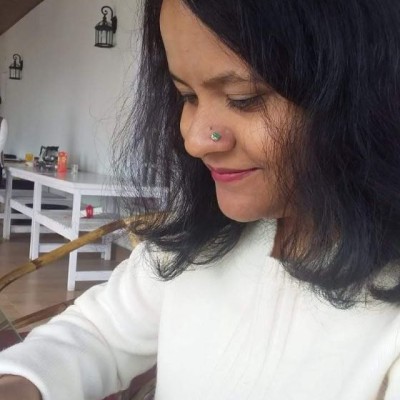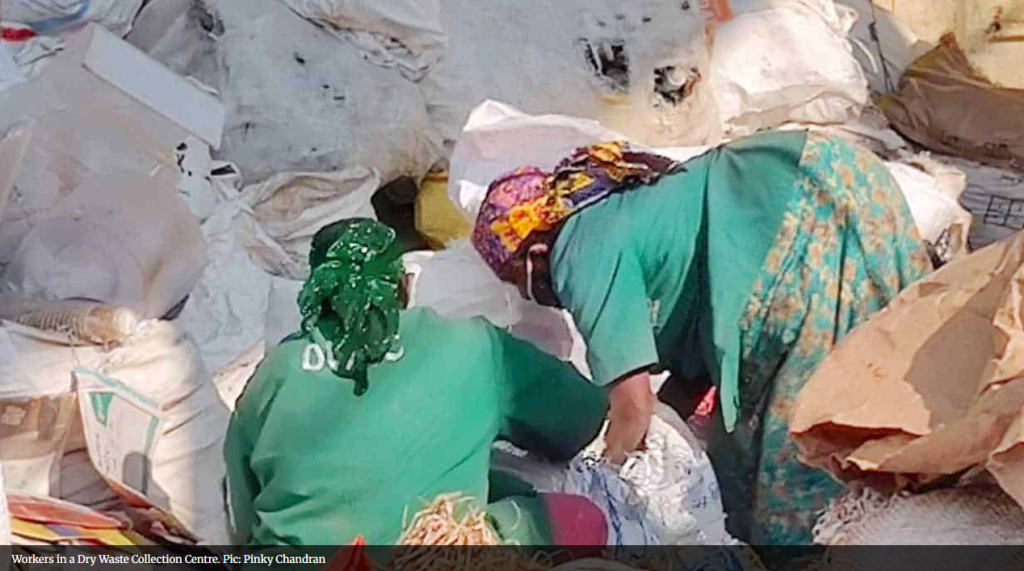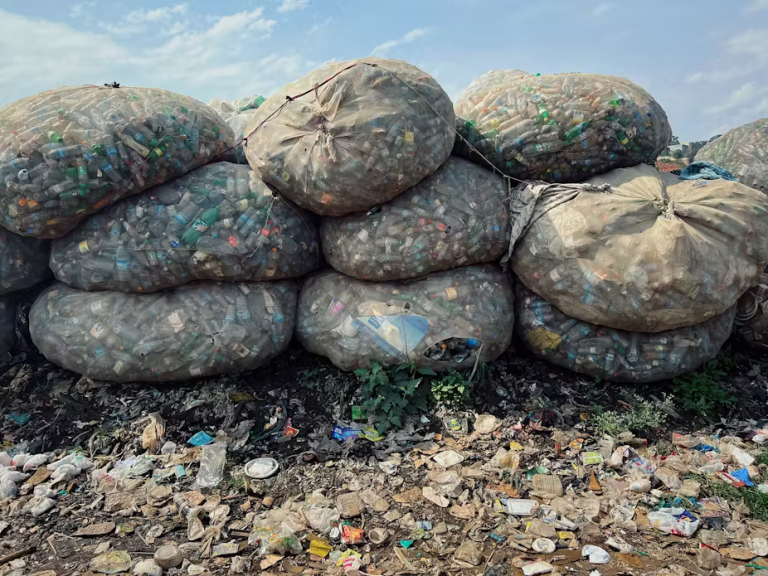The rise of fast fashion, coupled with citizens’ limited awareness about waste disposal, has led to a textile waste challenge in Bengaluru. The city generates 220 tonnes of textile waste everyday, which accounts for 4% of its municipal waste.
Managing urban textile waste goes beyond collection, sorting, and recycling — it should also take into account the needs of the frontline workers, the waste picker community. To address this challenge, waste pickers, with support from NGOs, have developed multiple solutions. In the past few years, they have set up Bengaluru’s first textile waste processing centre, a decentralised system to provide waste to this centre, and even a separate upcycling system that fashions new clothes out of waste.
These initiatives are currently in their nascent stages, and are expected to grow in the coming years.
Setting up a system to recover textile waste
Indumathi began working as a waste picker in Bengaluru 18 years ago. Today she owns and runs the city’s sole Textile Recovery Facility (TRF).
Her journey from waste picker to waste entrepreneur is inspirational. In 2011, she met the members of Hasiru Dala, a social impact organisation that works with waste pickers. And soon, she received her Occupational Identification Card, given by the municipal corporation BBMP in association with Hasiru Dala, to formally recognise waste pickers.
In 2016, she became the operator of the dry waste collection centre (DWCC) in ward 150 after signing an MoU with the BBMP. In 2018, she founded two waste management companies as well.
Over the years, she has formally employed 88 waste pickers, and trained four women waste entrepreneurs. In 2024, she won Namma Bengaluru Foundation’s Social Entrepreneur of the Year Award.
In 2024, she set up the TRF in Hirandahalli in the city outskirts, with a seed grant from Hasiru Dala and the Mumbai-based platform Circular Apparel Innovation Factory (CAIF). This was under the umbrella of Saamuhika Shakti, a collaborative initiative of multiple NGOs to support waste pickers.
The 3,800-sq ft TRF operates in a hub-and-spoke model, receiving textile waste from 16 DWCCs and directly from citizens and bulk waste generators. It recovers reusable textiles from the waste, which is collected by vendors who provide these to retail shops in the reuse market.
The TRF is expected to manage a significant share of Bengaluru’s textile waste in the coming years, and also to create green jobs and a favourable work environment for waste pickers.

Years before Indumathi started the TRF, Krishna, a waste picker, pioneered the idea of collecting and recycling textile waste. In 2017-18, he became the first waste picker in Bengaluru, with permission from the BBMP, to collect textile waste door-to-door on a trial basis.
With the learnings from this, in 2022, Hasiru Dala in collaboration with CAIF approached BBMP to scale up the DWCCs operated by Krishna through a special door-to-door textile waste collection drive. This project was supported by IKEA Foundation.
Later, Krishna and another waste entrepreneur, Kumuda, continued to collect post-consumer textile waste and developed a model to sort the waste for reuse, recycling, downcycling and repurposing. Based on the model, Kumuda set up her Textile Centre, which employs 17 people directly, and 20 others indirectly, under the DWCC in ward 117 (JP Nagar).
Kumuda was awarded the ‘Most Inspiring Women Entrepreneur – Circular Textile’ by the Confederation of Indian Textile Industry (CITI) at the CITI Textile Sustainability Awards 2024.
Hasiru Dala has replicated her model across 16 wards through its Hasiru Batte initiative, in collaboration with CAIF and with BBMP’s support. The organisation now collects textile waste through the DWCCs and also directly from homes. Nalini Shekar of Hasiru Dala says they collected 131 tonnes of textile waste in 2024.
Waste entrepreneurs like Indumathi, Krishna and Kumuda show the potential of scaling up DWCCs for urban textile waste management.
Challenges in scaling up the model
Somatish Banerji, Partner at Intellecap, the business consultancy company that set up CAIF, says their aim is to establish and scale an integrated Circular Textile Waste Management (CTWM) model in Bengaluru. The key goals are to recover value from textile waste and to create green jobs for waste pickers.
“We had piloted the CTWM model in Bengaluru under the ‘Closing the Loop’ programme, in close collaboration with Hasiru Dala. We continued our partnership with them under the Saamuhika Shakti programme from 2023. This gave us the opportunity to work with other partners in sync with Saamuhika Shakti’s vision of delivering collective impact to the waste picker communities in Bengaluru,” says Somatish.
The CTWM model aims to integrate three steps:
- hyper-local collection of textile waste, particularly post-consumer waste
- adding value through market-informed sorting of the collected waste
- markets linkages and transactions with different types of buyers of sorted waste
“We initially worked with DWCCs, operated by grassroot waste micro-entrepreneurs, to pilot the CTWM model in Bengaluru. To scale the model, we supported Indumathi to establish the TRF. Now we are helping the TRF establish market linkages with local buyers of textile waste as well as distant recycling markets like Panipat and Tirupur,” says Somatish. He adds that there is a clear hierarchy of waste based on different buyers’ requirements which could be resale, upcycling, recycling or downcycling.
Somatish adds: “We have been able to manage around 310 tonnes of textile waste so far. By the end 2026, we aim to manage 800 tonnes.”
The journey thus far, he says, has been challenging since the CTWM model had to be built from scratch. Though there has been significant progress in streamlining textile waste collection, the model can be sustained only by onboarding more buyers. Once it becomes sustainable, it can even incentivise citizens to give away their textile waste, says Somatish.

Upcycling waste into ready-to-use clothes, accessories
Citizens too can contribute to and benefit from textile waste management by purchasing upcycled clothes and accessories.
Sambhav Foundation, under the Saamuhika Shakti initiative, has been training women waste pickers to upcycle textile waste. The women create purses, laptop bags, tops and dresses from waste, which are sold on Twirl, an online store of upcycled goods. In 2024, Sambhav Foundation trained 150 women in tailoring across its three livelihood resource centres at Lalbagh, Goraguntepalya and Hebbal.
“We started the skill-as-a-service model training programme during Covid-19. The first phase of the collaboration between us and other partners under Saamuhika Shakti started at that time. All of us were doing work around textile waste management, but in isolation. We realised there was a huge gap and that we needed an integrated method. In 2023, we started the upcycling training programme,” says Dr Gayathri Vasudevan, Chief Impact Officer, Sambhav Foundation.
She adds that tailoring is often viewed as something for personal use, that is, for the home or family members. “When we train women in tailoring, we make them understand about the material, which is post-consumer waste. Because without that knowledge, the whole purpose of upcycling textile waste will be lost. It is important to create products that have market demand rather than just for social good. It is for this reason, we ensure we create products that the customer will find relevant.”
Nalini, a trainer at Sambhav Foundation’s livelihood resource centres, says, “Overall, I have trained about 450 women in tailoring. We upcycle jeans, felt and cotton textile waste. Our training is based on the concept of learning and earning, where a woman learns tailoring and simultaneously starts stitching at home.”
It takes about eight months to train a worker. “Some of these women have never stepped out of the house. But now, after our training, they earn money,” says Nalini.
“Currently, we take B2B orders on Twirl and don’t sell to individuals. But our long term plan is to sell in residential areas and to set up stalls. We are also looking to collaborate with other partners who work with both design and cost elements,” says Dr Gayathri.
Upcycled textile waste products have to compete with brands, however, consumers should consider the fact that these products are of quality and add value to society.
Source link : View Article
Author
-

Sravasti Datta is an independent journalist and editor. She is an Experienced Independent Journalist with a demonstrated history of working in the newspaper industry. Skilled in Journalism, Newspapers, Digital Media, and News Writing. Strong media and communication professional with a Diploma in broadcast journalism focused in Journalism from Asian College of Journalism, Chennai.



